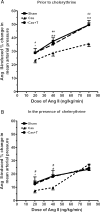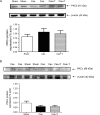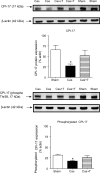Involvement of protein kinase C-CPI-17 in androgen modulation of angiotensin II-renal vasoconstriction
- PMID: 19797427
- PMCID: PMC2802204
- DOI: 10.1093/cvr/cvp326
Involvement of protein kinase C-CPI-17 in androgen modulation of angiotensin II-renal vasoconstriction
Abstract
Aims: Previous studies suggested that androgens augmented renal vascular responses to angiotensin II (Ang II). The protein kinase C (PKC)-CPI-17 pathway is involved in vascular constriction. We tested the hypothesis that this pathway may contribute to androgenic amplification of Ang II-renal vasoconstriction in the New Zealand genetically hypertensive (NZGH) rat.
Methods and results: NZGH underwent sham operation, castration, or castration with testosterone replacement at 5 weeks of age. When the rats were 16-17 weeks of age, mean arterial pressure (MAP) and renal vascular resistance (RVR) responses to intravenous Ang II infusion (20, 40, and 80 ng/kg/min) were recorded before and after treatment with a PKC inhibitor, chelerythrine. mRNA expression of PKC isoforms and CPI-17 protein expression were analysed in renal cortex. MAP and RVR responses to Ang II were enhanced in androgen-replete NZGH. The Ang II-induced increase in RVR was significantly lower in castrated NZGH (ranged from 100 +/- 8% to 161 +/- 9% of baseline) than in sham-operated NZGH (ranged between 123 +/- 3% and 237 +/- 19% of baseline). Testosterone treatment restored RVR responses to Ang II in castrated rats. Chelerythrine treatment markedly reduced the MAP and RVR responses to Ang II in each group and attenuated the differential MAP and RVR responses to Ang II amongst the three groups. PKCdelta and PKCepsilon mRNA levels were significantly reduced by castration and increased by testosterone treatment. In contrast, no significant differences in protein expression were detected for these PKC isoforms. Castration decreased while testosterone treatment increased CPI-17 and phospho-CPI-17 expression.
Conclusion: Collectively, these results suggest that androgens modulate renal vascular responses to Ang II in part via an effect on the PKC-CPI-17 signalling pathway.
Figures





Similar articles
-
Testosterone plays a permissive role in angiotensin II-induced hypertension and cardiac hypertrophy in male rats.Biol Reprod. 2019 Jan 1;100(1):139-148. doi: 10.1093/biolre/ioy179. Biol Reprod. 2019. PMID: 30102356 Free PMC article.
-
Androgens augment renal vascular responses to ANG II in New Zealand genetically hypertensive rats.Am J Physiol Regul Integr Comp Physiol. 2006 Jun;290(6):R1608-15. doi: 10.1152/ajpregu.00364.2005. Epub 2006 Feb 9. Am J Physiol Regul Integr Comp Physiol. 2006. PMID: 16469840
-
Androgens potentiate renal vascular responses to angiotensin II via amplification of the Rho kinase signaling pathway.Cardiovasc Res. 2006 Dec 1;72(3):456-63. doi: 10.1016/j.cardiores.2006.09.007. Epub 2006 Sep 19. Cardiovasc Res. 2006. PMID: 17049502
-
Role of protein kinase C in angiotensin II-induced renal vasoconstriction in genetically hypertensive rats.Am J Physiol. 1996 Jun;270(6 Pt 2):F945-52. doi: 10.1152/ajprenal.1996.270.6.F945. Am J Physiol. 1996. PMID: 8764313
-
Angiotensin II-induced changes in G-protein expression and resistance of renal microvessels in young genetically hypertensive rats.Mol Cell Biochem. 2000 Sep;212(1-2):121-9. Mol Cell Biochem. 2000. PMID: 11108143
Cited by
-
Reciprocal regulation controlling the expression of CPI-17, a specific inhibitor protein for the myosin light chain phosphatase in vascular smooth muscle cells.Am J Physiol Cell Physiol. 2012 Jul 1;303(1):C58-68. doi: 10.1152/ajpcell.00118.2012. Epub 2012 Apr 25. Am J Physiol Cell Physiol. 2012. PMID: 22538237 Free PMC article.
-
Endogenous inhibitor proteins that connect Ser/Thr kinases and phosphatases in cell signaling.IUBMB Life. 2012 Sep;64(9):732-9. doi: 10.1002/iub.1067. Epub 2012 Jul 20. IUBMB Life. 2012. PMID: 22815089 Free PMC article. Review.
-
Testosterone plays a permissive role in angiotensin II-induced hypertension and cardiac hypertrophy in male rats.Biol Reprod. 2019 Jan 1;100(1):139-148. doi: 10.1093/biolre/ioy179. Biol Reprod. 2019. PMID: 30102356 Free PMC article.
-
Antenatal Hypoxia Affects Pulmonary Artery Contractile Functions via Downregulating L-type Ca2+ Channels Subunit Alpha1 C in Adult Male Offspring.J Am Heart Assoc. 2021 Apr 20;10(8):e019922. doi: 10.1161/JAHA.120.019922. Epub 2021 Apr 10. J Am Heart Assoc. 2021. PMID: 33843249 Free PMC article.
-
The COP9 signalosome and vascular function: intriguing possibilities?Am J Cardiovasc Dis. 2015 Mar 20;5(1):33-52. eCollection 2015. Am J Cardiovasc Dis. 2015. PMID: 26064791 Free PMC article. Review.
References
-
- Bazan E, Campbell AK, Rapoport RM. Protein kinase C activity in blood vessels from normotensive and spontaneously hypertensive rats. Eur J Pharmacol. 1992;227:343–348. - PubMed
-
- Crofton JT, Share L. Gonadal hormones modulate deoxycorticosterone-salt hypertension in male and female rats. Hypertension. 1997;29:494–499. - PubMed
-
- Dubey RK, Oparil S, Imthurn B, Jackson EK. Sex hormones and hypertension. Card Res. 2002;53:688–708. - PubMed
-
- Fortepiani LA, Reckelhoff JF. Treatment with tetrahydrobiopterin reduces blood pressure in male SHR by reducing testosterone synthesis. Am J Physiol. 2005;288:R733–R736. - PubMed
Publication types
MeSH terms
Substances
Grants and funding
LinkOut - more resources
Full Text Sources
Miscellaneous

